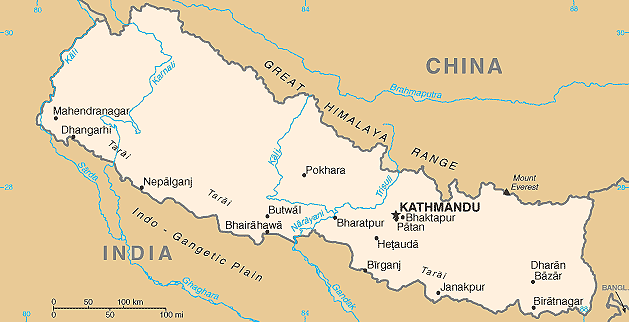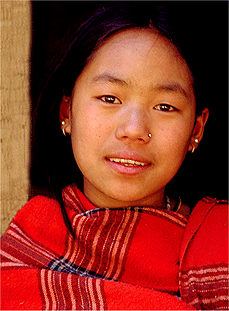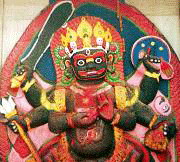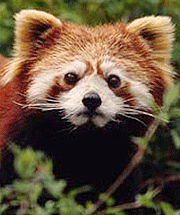|
|
|
General Information |
|
Official
name |
Nepal
Adhirajya (Kingdom of Nepal) |
|
Area |
3 147.181 Sq. km |
|
Inhabitants |
31.25 million |
|
Capital |
Kathmandu |
|
Political
System |
Multiparty
Democracy with Constitutional Monarch |
|
Official
Language's |
Nepali |
|
Religious
Groups |
Hindus
(89.5%), Buddhists (5.3%), Muslims (2.7%), Jains
(0.1%), Christians & others (0.023%) |
|
Currency |
Nepalese
Rupee (NR) |
|
National
Holiday |
07
July (Birthday of the King) |
|
|
|
|
|
Map of Nepal |

|
|
|
|
|
Information about Nepal |
|
Nepal is the
only Hindu kingdom in the world. Nepal is spread across the
main heights of the Himalayas and has always been a land of
fascination. Nepal is a land of great contrasts with high
Himalayan mountains, vast and icy glaciers, tiny houses,
ancient history, artistic monuments, exotic wildlife
sanctuaries, greenery and diverse cultures. It is the land
where Lord Buddha was born over 2,500 years ago. Nepal is
rectangular in shape, landlocked and covers an area of 147,181
square km. The capital of Nepal is Kathmandu. About half a
million people lives in Kathmandu. Every aspect of Nepali life
can be seen in Kathmandu, which is the center of travel and
adventure activities. The Kathmandu Valley is magnificent for
its wealth of unique temples. Nepali is the official language
of Nepal and is spoken by most of the people. Till 1951, Nepal
was a closed book for foreign visitors. Till 1964, it was
reserved only for hardy climbers and explorers. In recent
years, the country has opened its doors to foreign and Indian
tourists and millions of them visit this country every year.
The experiences of the travelers who visit the Nepal for the
first time are very different. Some of the tourists feels like
stepping out of a time machine, some are thrilled by the
pleasant atmosphere, while, some of them feel like living in a
permanently air-conditioned state. Nepal can be visited
throughout the year and in any season.
|
|
|
|
|
History of Nepal |
|
In the earlier days, Nepal was divided into small principalities which were fighting against each other. It was not till the arrival of the Mallas from north India that Nepal was launched into its first flowering of social and artistic creativity. The Mallas also took control of a major part of Nepal and Tibet. But, pattern of small, independent kingdoms continued and Nepal could not be unified. The Mallas had three separate kingdoms in the Kathmandu Valley itself, with their capitals at Kathmandu, earlier known as Kantipur, Patan, known as Lalitpur and Bhadgaon, known as Bhaktpur. The Mallas left their stone inscriptions in temples and carved them on the bases of statues. As the Mallas grew weaker due to family feuds, they were replaced by the Shahs. It was during the rule of King Prithvi Narayan Shah (1730-75) that Nepal became more unified. He came from the Gurkha region. He was the first to use these tough fighters to strengthen his rule. The Gurkhas are still valued as great fighters and a large number of them are serving in the Indian and British armies. The King Prithvi Narayan Shah was responsible for the exclusion of European traders from the country. As the Shah dynasty became weak, the Ranas took over Nepal in 1846. The monarch only became a figurehead while the Ranas ruled the country. Nepal lost war to the British in 1857 and accepted their nominal allegiance. As a result, the Gurkhas fought several wars for Great Britain. They sided with them during the first War of Indian Independence in 1857. The British were so pleased with their loyalty that they returned some of the territories they had occupied after the defeat of the Nepalese. Subsequently, the Gurkhas fought other battles for Britain, including World War I & II. They fought in all parts of the World. After a popular revolution made by the ninth King Tribhuvan of Shah dynasty in 1950-51, the Ranas were defeated. The King Tribhuvan died in 1955 and was succeeded by his son Mahendra. Nepal became a member of the United Nations in 1955. The King Birendra Bir Bikram Shah Dev was the 10th king in the dynasty. The King Birendra
abolished party system. In 1990, a popular democratic revolt
led to the re-establishment of a multi-party democratic system
based on adult franchise. The new democratic Constitution of
the kingdom was promulgated on November 9, 1990. The king
remains the titular head of the government. In 1994, Nepal
elected communist party to form the government which has since
been replaced by coalition government. |
|
|
|
|
Geography of Nepal |
|
Nepal is bounded in the north by Tibet – the autonomous region of China, in the east by Sikkim and West Bengal, in the south by Bihar and in the west by Uttar Pradesh. The land extends approximately for 885 km from east to west, and 193 km from north to south. The land in Nepal can be broadly divided into three regions which are Himalayan region, Mountain region and Terai region. The altitude of the Himalayan Region ranges between 4877 metres and 8848 metres with the snow-line running around 4877 metres. It includes all the major peaks of the Himalayas. The mountain region covers about 64 percent of the total land area of the country. It is formed by the Mahabharata Range which soar up to 4877 metres. The lowland Terai region lies at an altitude of 305 metres and occupies about 17 per cent of land area. Kachanakawal, the lowest point in the country, has an altitude of only 70 metres. It is located in Jhapa district of eastern Terai. The land rises from the Terai, the southern plains covered with tropical jungles and fertile farm land at almost sea level to the high Himalaya mountains in the north with valleys and lush hills in between within a distance of less than 200 km. The lowlands of the Terai are about one hundred metres above sea level. This, together with monsoon rains along the slopes facing south has resulted in compacting virtually all climate zones on the earth. Except the Terai region in the extreme south, the mid-valleys are seldom higher than 1220 metres above sea-level. Out of the ten peaks, eight highest peaks lies in Nepal. The Himalayas are the youngest and the highest mountain chains in the world. About a third of its 1000 km. long Himalayan range lies within Nepal. It has a convergence of 1310 magnificent pinnacles and peaks over 6000 metres including the world’s eight of the 14 giant peaks over 8000 metres high. Mount Everest, the world’s highest peak and Kanchanjunga, the third highest peak lies in Nepal. The other six peaks in Nepal are Lohtse, Makalu, Cho Oyu, Dhaulagiri, Manalsu and Annapurna I. Some of these unconquerable mountain peaks provide a vivid contrast with hand-sculpted landscape of farms in mountain valleys.
|
|
|
|
|
Climate in Nepal |
|
Nepal is a land of extreme contrasts as far as the climatic conditions are concerned. The climate in Nepal ranges from the subtropical monsoon conditions in the Terai region to cool temperate conditions in the higher areas and an alpine climate with snow and extreme day temperature in the mountains. As Nepal is situated in the northern hemisphere, so during the summers, it is the rainy season in Nepal. The monsoon lasts across the whole country from June to September when over 75% of the annual rainfall occurs. The amount of rainfall decreases from south to north and from east to west. The Mahabharat Lekh forces the moist monsoon airstream to rise that causes heavy rains on the hills in the south, especially in the Terai region. The Spring season is warmer than the autumn. In the high mountains in winters, the temperature drops below zero, while in the Kathmandu valley, daytime temperature rarely drop below 10 degrees Celsius. Pokhara is lower and warmer and more pleasant than Kathmandu in winter but hotter, more humid and less comfortable in summer. The post-monsoon period from October to November is characterized by settled weather, clear skies, no rain and moderately high temperatures. As winter approaches it gets cooler, especially at night. This is an ideal time to visit Nepal.
|
°C |
Jan |
Feb |
Mar |
Apr |
May |
June |
July |
Aug. |
Sep. |
Oct. |
Nov. |
Dec. |
|
Day |
22 |
24 |
26 |
29 |
28 |
28 |
31 |
30 |
31 |
28 |
26 |
23 |
|
Night |
-5 |
-1 |
-2 |
6 |
7 |
8 |
10 |
18 |
19 |
14 |
5 |
-3 |
|
Rainfall |
1 |
5 |
2 |
6 |
10 |
15 |
21 |
20 |
12 |
4 |
1 |
0 |
|
|
|
|
|
Economy of Nepal |
|
Nepal is primarily an agricultural country. About 90% of the population is engaged in agriculture, and there are very little industries. The Terai region occupies 23% of the land area and contains 42% of the population, is the most productive region. It accounts for over 80% of Nepal’s rice, and 65% of its wheat. Cash crops like sugar cane, jute, tobacco and tea also important. The Hill region occupies 43% of the area and contains 50% of the population. The fertile Kathmandu Valley contains 10% of the hill population and is the center of government. The mountain region occupies 34% of area, but only 8% of its people. This region is inhabited by the pastoral nomads. Most hill and mountain farm households own livestock whose main contribution to human existence is through their provision of manure and draught labour. A small surplus of grain and industrial products are exported to India. Carpet, jute, brick, sugar, cigarette, saw mill, rice mill, oil mill, beer and garments are the major industries. Tourism is one of the biggest foreign exchange earners.
|
|
|
|
|
People of Nepal |
|
It is believed that the first inhabitants of Nepal were Mongoloid or Tibetan who migrated to the fertile valleys in the south. They were mainly Buddhists who follow the Tantric rituals of Tibetan Buddhism. In the early centuries of the Christian era, they were joined by Indo-Aryans or Hindus from northern India, who took the charge of the country. They were followed by the Lichhivis who were Buddhists converted by Lord Buddha himself. The people were charming, naturally friendly and virtually untouched by the social, political and commercial changes taking place beyond its borders. Those early travelers were effusive in their praise of this wonderful but economically backward land. Today, the different races and tribes of people live in different regions of Nepal.
They follow varied customs, traditions, wear different costumes and speak different languages. The Rais, Limbus, Magars and Gurungs mainly lives in the eastern mountains and on the southern slopes of Annapurna Himachulti and Ganesh Hamal. They are popularly known as the Gurkha soldiers. The Sherpas popularly known as “tigers of snow” live to a height of 4000 metres and are the tough mountain climbers.
The Sherpas have easy access to Bhot (Tibet) for trade
and social intercourse and therefore Tibetan
influence on their culture and civilization
remains distinct. The Newars and Tamangs mostly inhabit the Kathmandu valley.
The Tharu and Dhimals live in the Terai region. Brahmins, Chhetris and Thakuris are spread over the hills and valleys. The midlands are inhabited by various Tibeto-Burman and Indo-Aryan speaking hill and valley people. The people of Nepal mostly wear the handmade natural fiber cloth men and women in cotton, hemp, and wool.
More.... |
 |
|
|
|
|
|
|
|
Religion in Nepal |
 |
About ninety per cent of the people are Hindus, 5.3 per cent are Buddhists, 3% are Muslims and the rest of the people comprises of other religion. Hinduism and Buddhism are the two major religions in Nepal.
There is a complex blend of Hinduism and Buddhism in Nepal. Although a Hindu kingdom, all deities are worshipped by Hindus and Buddhists alike. A remarkable feature of the land is the mutual bond of friendship between the people of the two religions.
Buddhists are mainly found along the northern border area and in the eastern part of the country. Hindus are found in the south and west and Muslims are mainly concentrated along the border with India. |
|
|
|
|
Festivals of Nepal |
|
The rich cultural heritage of Nepal is manifested by the diverse social customs and festivals. Some of the festivals which are celebrated in Nepal are Nepalese New Year, Linga Jatra or Bisket, Buddha Jayanti, the Red Machhendranath Rath Jatra, White Machhendranath Rath Jatra, Dhumji, Losar Festival, Gai Jatra, Desain, Durga Puja, Indra Jatra, Diwali and
Shivaratri.
More.... |
|
|
|
|
Languages of Nepal |
|
Most of the people speak the Nepali language. The Nepali is written in Devanagri script and is the official language of Nepal. Nepali, Maithili, Bhojpuri, Tharu, Tamang and Nepalbhasa are the various languages which are spoken by more than half a million people. English and Hindi are widely understood in the urban centers.
|
|
|
|
|
Tourist Attractions in Nepal |
|
The city of Nepal comprises of three royal cities of Kathmandu, Patan and Bhaktapur. Nepal is the vast open-air museum of Newar culture with its colossal ensemble of sculptures, temples, monuments and magnificent art. The tourist attractions in Nepal are Kathmandu, Nsgarkot, Dhulikhel, Daman, Pokhra, Royal Chitwan National Park, Lumbini, Patan and Bhaktapur. The famous tourist attractions in Kathmandu are the Durbar Square, Swayambhunath Stupa, Bodhnath Stupa, Pashupatinath Temple, Temple of Living goddess Kumari and Changu Narayan temple.
|
|
|
|
|
Wildlife in Nepal |
|
The main vegetation found in the Terai region are deciduous forests. The sal and teak are the main trees that are found in the Terai region. The grasslands are found in the far west and smaller areas in the mid west. The wide variety of wildlife is also found in the national parks in the Terai region. There are few wild animals in the central zone because of the lack of forest and other natural vegetation.
Some of the famous national parks are Bardia National Park, Chitwan National Park, Sukla Phanta National Park and Koshi Tappu Wildlife Reserve.
The Chitwan National Park is the last home of the one-horned Great Indian Rhinoceros. Tiger, elephant, wild boar, Himalayan bear, leopard, gaur, sloth bear, musk deer, swamp deer, Red panda, striped hyena and various other animals are found in the national parks. Nepal is also home of a wide range of bird life like Impeyan pheasant, mahseer, snowcock, snow partidge, choughs, buntings and redstart.
More.... |
 |
|
|
|
|
Entry Regulations in Nepal |
|
All the tourists, except the Indian nationals must have a valid passport and visa, before entering Nepal. The tourist visa can be obtained from any Royal Nepalese Embassy or Consulate valid for a period of 30 days. Visas can also be obtained for 15 days on arrival at the Tribhuvan International Airport in Kathmandu or at the other places. On arrival at the airport, you must produce the disembarkation card and fill up the embarkation card when you depart. All the tourists are also required to pay an airport tax. |
|
|
|
|
Currency in Nepal |
|
The main currency of Nepal is the Nepali rupees (NR). The facilities for coverting foreign currency into the Nepali Rupees are available at the international airport, banks and hotels. The hotel bill can also be settled in the foreign currency. Tourists are also advised to obtain the encashment receipt in the exchange of foreign currency. It will help them to reconvert the leftover Nepali Rupees into dollars. The Indian Nationals can also bring the Indian rupees which can be easily accepted in the shops and hotels. |
|
|
|
|
Time in Nepal |
|
The time in Nepal is 5 hours 45 minutes ahead of the Greenwich Mean Time and 15 minutes ahead of Indian Standard Time. |
|
|
|
|
Cuisine of Nepal |
|
The cuisine of Nepal is similar to Indian cuisine. Some of the dishes are prepared in similar way like the Indian dishes. In Nepal, rice is the most common food and in most of the hotels almost all the 3 meals comprise of rice. The menu comprises of varieties of Indian, Chinese, Mexican, Italian and German dishes. The Nepali food is generally very spicy and hot. It is eaten without starters, soups or courses. A typical Nepali meal consists of rice, at least one lentil curry called dal,
one or more vegetarian servings, meat and/or fish, chutneys
and pickles. Most of the people in Nepal are vegetarian and
non-vegetarian dishes are not a part of the daily menu. |
|
|
|
|
Shopping in Nepal |
|
Kathmandu is a shopper's paradise. While roaming in the markets, one could see that Nepal is highly influenced by the Hinduism & Buddhism. All the masks, figures and various items are based on Hinduism and Buddhism. The most popular shopping items in Kathmandu are the Tibetan carpets, Jewellery, pottery, art and craft items, leather jackets, hand made belts, statues of Lord Buddha, wooden toys, decorated metal knives and varieties of hand-made garments like shawls, sweaters, trousers and caps. The customers can get a better bargain as the first price quoted is always higher than the price that will eventually be accepted for commodities. |
|
|
|
|
How to reach Nepal |
|
Nepal is adequately served by major international airlines besides its own national carrier - Royal Nepal Airlines. Some of the airlines which operates flight to Kathmandu are China, Lufthansa German Airlines, Pakistan International Airlines, Indian Airlines, Thai International and Singapore. It also operates flight to Europe, USA, India, China and Japan. The tourists can also enter into Nepal from India through the Terai region by a picturesque highway built by India. It is also not difficult to reach any part of Nepal through any means of transport, but there is no railway network within Nepal. |
|
|
|
|
|
|

